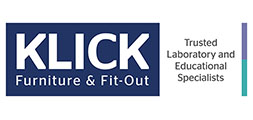12 Apr Pharmaceutical Lab Design
Laboratories are key for pharmaceutical companies. They are necessary for a range of activities from basic research, the drug development process and through to the final quality control of production batches.
Pharmaceutical lab design requires the careful consideration of various factors to ensure the space meets regulatory standards, operational needs and safety requirements.
Here are some key design features that are essential for a pharmaceutical lab:
1. Cleanroom Design for Pharmaceutical Labs
Cleanroom facilities are often required to maintain controlled environments for research and manufacturing processes. They are designed to ensure the sterility of pharmaceutical products by minimising airborne particles and other contaminants. Design features such as fume cupboards, high-efficiency particulate air (HEPA) filters and specialised HVAC systems are essential for controlling air quality and preventing contamination.
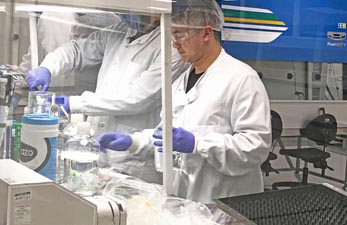
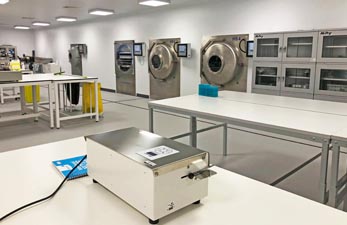
Biofortuna’s positive pressurised cleanroom facility was installed as part of the fit out of their new headquarters and minimised contamination for their manufacturing processes.
2. Controlled Environment Design for Pharmaceutical labs
Pharmaceutical labs require robust ventilation systems to maintain air quality, control odours and remove harmful fumes and gases from the workspace. Specialist fume cupboards, ductwork, air filtration units and pressure differentials can be used to create a safe and healthy working environment.
Humidity control may be required to keep products stable, to ensure samples/materials aren’t contaminated and to preserve the accuracy of results.
Whilst it is critical to provide the technical systems necessary for the lab to function, it is also advisable to minimise the areas needing controlled environments, in order to limit cost and complexity in design.
3. Scalability and Flexible Design for Pharmaceutical Labs
Agile design is required to accommodate new equipment and technological developments with the minimum of disruption. It is important to satisfy the need for future changes in requirements.
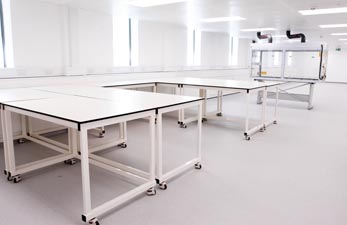
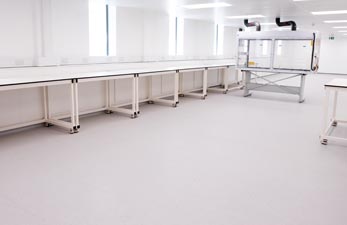
Synature Discovery are experts in advancing drug discovery projects into clinical development. They specified robust mobile laboratory workstations which can easily be moved around and secured into position with heavy duty lockable castors. The laboratory fit out project illustrates how modifications to the layout can accommodate changes in workflow or growth in staff numbers.
4. Pharmaceutical Laboratory Layout
Lab design should seamlessly integrate lab furniture and services to create a streamlined and practical workspace which will increase efficiencies. Efficient material flow will improve workflow and minimise the risk of cross contamination. An open floor plan can be beneficial to encourage collaboration and the visibility of other lab users is also an important consideration.
The laboratory layout should facilitate interaction between scientists and researchers and collaboration zones should be planned into the broader workspace for this purpose.
Testimonial:-
“Biofortuna now have a cutting edge manufacturing and laboratory facility with state of the art functionality which suits our needs perfectly. There is flexible workspace where our laboratory and technical teams can work collaboratively, which will be brilliant for us. The quality of the whole facility is absolutely top notch.”
Dr Nick Ash – Chief Executive Officer, Biofortuna Limited
5. Specialist Furniture for Pharmaceutical labs
Specialist workstations are necessary for activities such as drug formulation, analytical testing and sample preparation. Design features like reagent shelving, height-adjustable benches, anti-vibration tables and ergonomic seating can enhance the efficiency and comfort of lab personnel performing these tasks.
Fixed laboratory benching can accommodate storage and sink units which are necessary for wet lab areas.
The specification of the laboratory worktops will depend on the particular tasks being performed and will have an impact on the longevity of your workspace. It is important to consider chemical, scratch and wear resistance and find a balance between functionality and aesthetics.

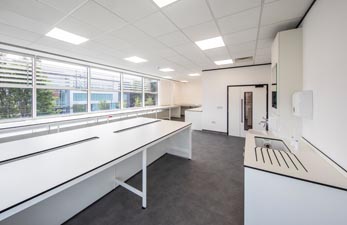
These Cat 2 labs facilitate the delivery of Oxford BioDynamics’ drug development programmes for the pharmaceutical and biotechnology industry.
6. Quality Control and Testing Areas
Designing separate areas for quality control testing and analysis is essential in pharmaceutical labs. These spaces should be equipped with specialist equipment, instruments and work surfaces to ensure accurate testing and compliance with regulatory standards.
7. Chemical Storage and Handling
Proper storage and handling of chemicals is critical in pharmaceutical labs. Segregated storage areas for hazardous materials are necessary to ensure the safety of lab personnel and the integrity of research samples.
8. Emergency Response Equipment
Designing pharmaceutical labs involves incorporating features such as emergency eyewash stations and safety showers. These are essential for quickly addressing accidents, spills or other emergencies that may occur during lab operations.
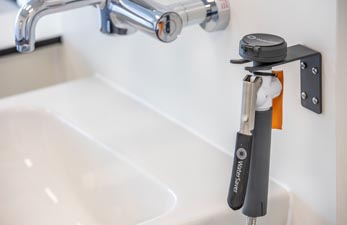
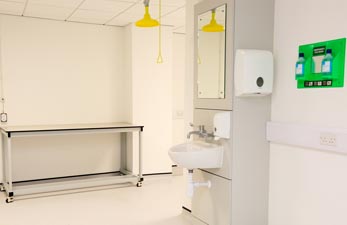
9. Data Management Systems
Pharmaceutical labs rely on data-intensive processes for research, analysis and documentation. CAT6LSF cabling supports seamless data sharing. Digital tracking tools and secure server rooms are necessary to effectively manage and store research data while ensuring data integrity and security.
10. Compliance with Regulatory Standards
Pharmaceutical labs must adhere to stringent regulatory standards. Design features that facilitate compliance, such as designated cleanroom zones, material flow layouts and documentation procedures are essential for meeting regulatory requirements and obtaining necessary certifications.
By incorporating these essential design features into the layout and infrastructure of a pharmaceutical lab, you can create a safe, efficient and compliant workspace that supports the research, development and manufacturing activities of pharmaceutical professionals.
Our consultants will be happy to discuss your pharmaceutical laboratory design project and the steps required to ensure the success and integrity of your lab operations. Please call 0161 998 9726 or contact us by email to arrange a consultation.
